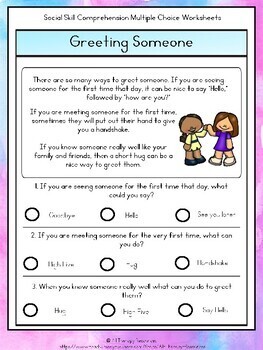

This meant he had mastered the lesson and no longer needed the color-coded hint. Soon he told me he was ready for white cards. Loren was familiar with my color-coded systems, understanding that if he simply matched the colors he would have the correct answers.) As soon as the color clue was supplied, he could line up the blue and yellow cards according to color.Įach day Loren got another chance to line up the blue and yellow cards on the chart, studying over the information. (It is important to ensure success when teaching unknown social information, thus the built-in color coding is something I often use. This gave him the visual hint – blue cards in the blue card column, yellow cards in the yellow card column. He studied this over, then removed the cards, mixed them up and announced, “I’m doing it myself this time.”ĭuring his first few tries, Loren wasn’t sure where to put the cards so I placed a blue card above the Expected Responses column and a yellow card above the Unexpected Responses column. Loren watched as I made the cards and put them under the columns of Expected Responses and Unexpected Responses. Yellow index cards were used to record each unexpected response such as “Shut up” and “Go away.” A blank card was used to indicate no words spoken. Next, blue index cards were used to write possible expected responses such as “Good morning” and “I am fine. I wrote in the Greeting/Question such as “Good morning” and “How are you?”ģ. I drew a chart on a piece of paper with columns labeled Social Greeting/Question, Expected Responses, and Unexpected Responses.Ģ. Once I realized his autistic brain had not picked up the hidden curriculum information regarding social greetings and rhetorical questions, I set about directly teaching this to Loren.ġ. Each morning when Loren arrived, I would say, “Good morning, Loren.” Loren would either remain silent or say, “Shut up” or “I know that.”Īs we walked down the hall to his locker, I would tell him it was nice to see him and ask, “How are you?” Loren either would remain silent or give me a detailed rundown of all his scrapes and bruises, both current and from years past! I did a one-on-one “check-in” time with him each day before he left to go to his first classroom. Even so, autistic people can learn those things their particular brain hasn’t allowed them to pick up automatically.Įxample: I supported a 6th grader at school for an hour a day as he entered, checked in at the office, and went to his locker. The autistic brain simply works differently. Instead, it is because all social information (often referred to as the “hidden curriculum”) is not automatically picked up and used by a person with an autistic brain. This is not because they are rude, obnoxious, don’t care, or any of the other assumed reasons people attribute to this behavior.
#Autism social questions how to
Permission to copy for single classroom use only.Įlectronic distribution limited to single classroom use only.On in Education Autism, Social Greetings and Rhetorical QuestionsĪutistic people may not automatically know how to respond to rhetorical social questions such as “How are you?” or automatically reciprocate in social pleasantries such as “Good morning.” Interested in joining collaborative boards? I have many! Check it out:

Social Skills: Perspective Thinking Skillsįeedback is always appreciated, very helpful, and you receive TPT credits towards future purchases. ★Or consider getting Conversation Skills which includes 20 social questions and a variety of other activities: Another option is for students to write their answers on the back of each card and practice asking/ answering with each other. You can cut, laminate, put on a key ring, and use one set for individual practice or group conversation practice. 30 question cards that can be used to practice social questions individually or used to spark conversation topics during social/ language groups.


 0 kommentar(er)
0 kommentar(er)
